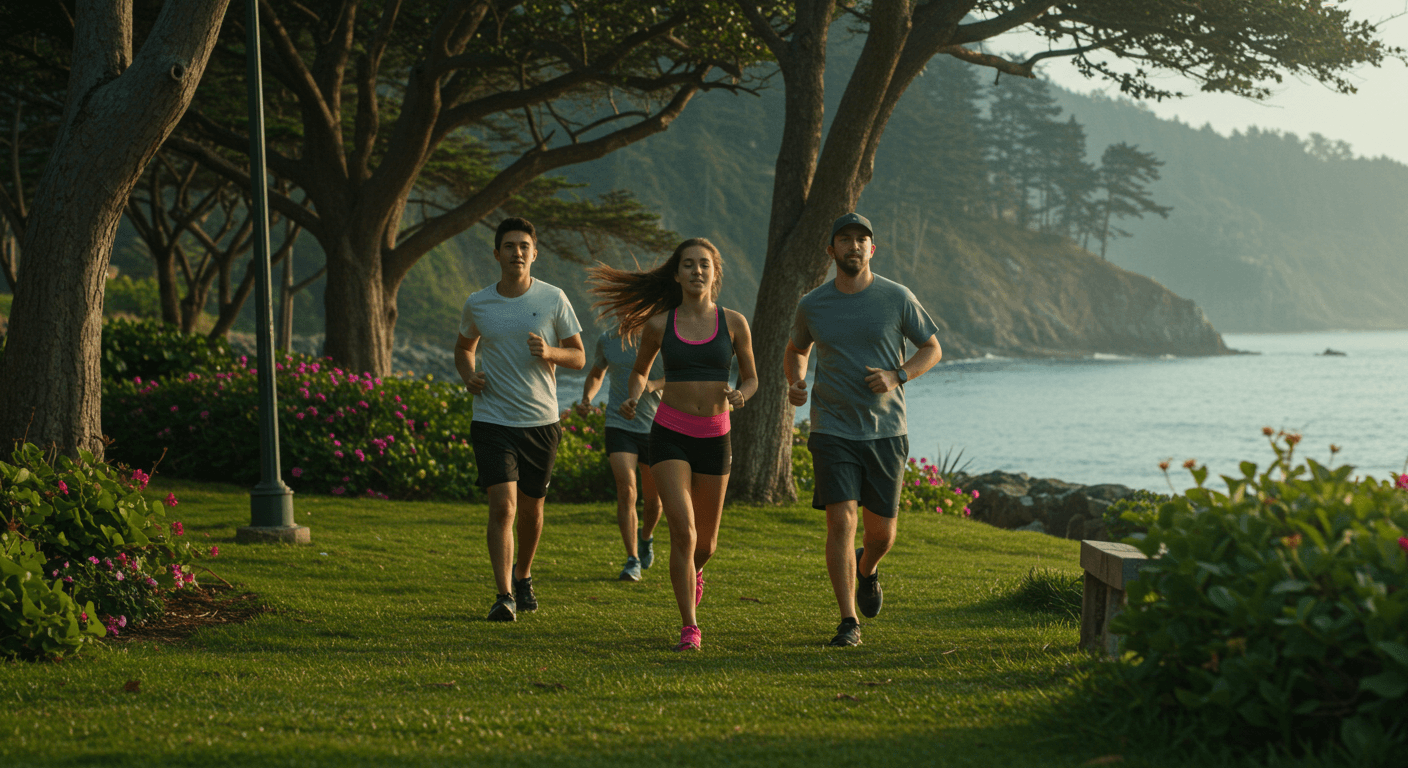Top Takeaways and Key Concepts
Maintain proper posture: Stand tall, with shoulders back and ears over your shoulders to align your spine.
Focus on foot strike: Aim for midfoot striking to absorb shock and reduce leg impact.
Practice deep breathing: Use belly breathing with slow inhales and exhales to improve oxygen flow.
Swing your arms correctly: Keep elbows at 90 degrees and swing arms naturally to help with balance and momentum.
Incorporate strength training: Build core stability with exercises like planks to improve posture and form.
Summary of This Article
The article emphasizes the importance of proper jogging technique to improve performance and reduce injury. Key tips include maintaining good posture by standing tall with shoulders back, striking with the midfoot to absorb shock, and practicing deep belly breathing to ensure proper oxygen flow. Arm movement should be fluid and natural, with elbows bent at 90 degrees to aid in balance. Strength training, particularly core exercises, helps support good form while jogging. The article also encourages using feedback from others or recording your runs to spot areas for improvement, making jogging a more efficient and enjoyable experience.

You might believe that the most important thing about jogging is putting one foot in front of the other. I mean, how tough can it be? Put on those sneakers and you're ready to go! But listen up, my friend: if you don't pay attention to your form, you could wind up looking like a giraffe on roller skates, which is awkward and could hurt you. Let's go into how to improve your jogging technique so you may get greater results without making your training look like a circus act.
Understanding Proper Posture

First things first: posture is key. Imagine trying to balance a stack of books on your head while walking. If you're slouching like a deflated balloon, good luck keeping that stack intact! The same goes for running. You want to stand tall with your shoulders back and relaxed. Think about creating a straight line from your head down through your spine. Your ears should be over your shoulders, which means no leaning forward like you're trying to eavesdrop on the neighbor's gossip.
Interestingly enough, many joggers forget about their arms entirely or swing them around like they’re trying to swat away invisible flies. This can throw off your rhythm and make it feel like you're running uphill during an avalanche! Keep those elbows bent at about 90 degrees and swing them naturally by your sides as you run—like you're conducting an orchestra where every note is “I’m almost done with this mile!”
Foot Strike Fundamentals

Let's see… Next is foot striking, which is more important than whether or not you remembered to wear matching socks. Heel striking, midfoot striking, and forefoot striking are the three basic types of foot strikes. Heel striking seems sophisticated, but it might hurt your legs since landing hard on your heels can send shockwaves through your legs, like when you jump onto pavement in flip-flops.
Most runners do best when they strike in the middle of their foot since it absorbs shock better and doesn't feel like they've just stomped on burning coals. To get better at this, strive to fall softly under your body instead of in front of you. Think of gravity as a friend instead of an enemy.
Breathing Like a Pro

Now let's talk breathing because believe me, if there’s one thing that can ruin a jog faster than stepping in dog poop—it’s improper breathing! When we jog, our bodies need oxygen like my dog needs treats (which is all day long). A common mistake beginners make is taking shallow breaths that resemble someone gasping after forgetting how to swim.
To improve this aspect of your form, focus on deep belly breathing rather than just filling up those tiny lung pockets at the top. Inhale deeply through your nose for four counts and exhale slowly through pursed lips over six counts—it’s kind of like blowing out birthday candles while making sure none land on the cake!
Arm Movement Matters

By the way, have you ever noticed how professional runners seem so effortless? Part of that magic lies within their arm movements! Your arms play an essential role in maintaining balance as well as momentum during each stride. Swinging them correctly helps propel you forward instead of letting them flail around aimlessly—because trust me; no one wants to look like they’re battling invisible ninjas mid-run!
As mentioned earlier, keep those elbows bent at 90 degrees and avoid crossing them across your body (unless you're practicing some bizarre interpretive dance). Instead, allow them to move back and forth alongside you naturally—think about running as if there's an invisible string pulling you along from behind.
Mind Over Matter

When you want to improve your form, don't forget how powerful mental tactics may be. Our imaginations often start to play tricks on us halfway through a jog. Instead of focusing on our form, we start to think about pizza or why we didn't wear our lucky socks today. Mindfulness while running can help us stay focused on keeping good form and keep distractions at bay.
Try setting little goals for each run. For example, you may focus on your posture for two minutes before switching to breath control the following time. Before you know it, you'll be gliding along easily instead of looking like someone who just got chased by bees!
Incorporating Strength Training

Honestly speaking though… it may sound counterintuitive… but incorporating strength training into our routines helps build core stability which directly impacts jogging form too! A strong core supports good posture throughout any physical activity including running; think planks or squats rather than spending hours staring blankly at gym equipment pretending we know what we're doing!
You don't have to become Arnold Schwarzenegger overnight but adding even ten minutes twice weekly will yield noticeable improvements over time—not only will this help reduce injury risks but also boost overall performance levels leading towards better results!
The Power of Feedback
Speaking of getting better, one of the best ways to improve your jogging technique is to ask other people for their opinions! Ask friends or family who also like to run. They could notice something small that could make a big difference, like suggesting that you wear pants instead of shorts when it's cold outside.
Another choice is to record yourself while jogging and then watch the footage later. You might find that you move with grace like a gazelle running through a field, or you might notice that you do tend to be uncomfortable as you dodge squirrels in mid-stride!
So there you have it: a treasure chest full of advice on how to improve your jogging technique while keeping laughter a big part of this journey to becoming healthier versions of ourselves! With these tips and a little patience, we'll all be walking down the street with more confidence and appearing less like giraffes and more like graceful gazelles than ever before!
Suggested Resources:
How Running Form Affects Performance
https://www.runnersworld.com/health-injuries/a20831326/how-running-form-affects-performance/
The Importance of Good Running Form
https://www.active.com/running/articles/the-importance-of-good-running-form
Improve Your Running Technique
https://www.coachmag.co.uk/running/7055/improve-your-running-technique
Frequently Asked Questions
Why is proper posture important when jogging?
Good posture improves breathing, reduces strain on your joints, and helps you maintain an efficient stride while running.
What is the best foot strike for jogging?
Midfoot striking is ideal because it absorbs shock more effectively and reduces impact on your legs compared to heel striking.
How can I improve my breathing while jogging?
Practice deep belly breathing, inhaling through your nose and exhaling slowly through your mouth to maximize oxygen flow.
How should my arms move while jogging?
Keep elbows bent at 90 degrees and swing your arms naturally at your sides to maintain balance and support forward momentum.
Why does core strength matter for jogging form?
A strong core supports proper posture, improves stability, and helps maintain consistent form throughout your run.
Can mindfulness improve jogging form?
Yes, staying mentally focused helps you maintain posture, breathing, and rhythm instead of falling into sloppy habits.
How can I identify flaws in my jogging form?
Ask for feedback from others or record yourself running to spot issues like posture imbalance or inefficient arm movement.

Kevin Collier is a passionate fitness enthusiast dedicated to promoting healthy living through jogging and running. With years of experience in exercise science and a keen interest in weight loss strategies, Kevin shares valuable insights and tips to help individuals achieve their fitness goals. His content on WebJog.com aims to inspire readers to embrace an active lifestyle, emphasizing the benefits of consistent exercise for both physical and mental well-being. Whether you’re a seasoned runner or just starting your fitness journey, Kevin’s expertise and encouragement will motivate you to stay active and live your healthiest life.




